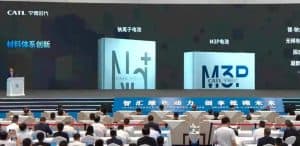
Following reports out of China earlier this month, battery behemoth CATL has confirmed the production of its M3P batteries that will deliver next year. Although the chemistry may be similar, CATL has said the M3P batteries vary from Lithium Manganese Iron Phosphate (LMFP) cells.
Contemporary Amperex Technology Co Ltd., aka CATL, is a global energy technology company and the leading EV battery manufacturer in China. Beyond Asia, the company has retained its crown as the world’s largest battery manufacturer by installed capacity for a fifth-straight year.
Earlier this month, rumors began to surface about CATL’s “M3P” batteries, which were briefly mentioned by the battery company in February amongst other upcoming technologies like sodium-ion batteries.
The initial assumption was that CATL’s M3P chemistry was that of LMFP, as local Chinese media said the chemistry had passed interim tests earlier year and CATL would now be sending samples to automakers for further testing.
As CnEVPost pointed out, a source close to CATL’s investor relations team revealed a day later that the company is fact developing its M3P batteries, but their chemistry is different from that of an LMFP battery.
Now CATL has officially come out and confirmed just that, although we don’t know much else about these M3P batteries.
CATL’s M3P batteries should cost less than LMFP chemistry
At the 2022 World EV & ES Battery Conference in China yesterday, CATL chief scientist Wu Kai said the M3P batteries have already reached volume production and will hit the market in 2023. CATL chairman Robin Zeng also briefly mentioned the M3P batteries for the first time since February, but offered no additional details.
What we’ve learned from investigative reports in China following the misreported news of the M3P batteries containing LMFP chemistry is that the former are similar, but not quite. CATL says the M3P cells also contain other metallic elements not present in LMFPs.
Instead, the company prefers to refer to the upcoming technology as a “ternary lithium battery of the phosphate chemistry system,” according to a report from Gasgoo. Regardless of what makes up the M3P batteries, they are promised to deliver greater energy density than lithium iron phosphate (LFP) batteries, but at cost parity with ternary-lithium cells.
We don’t yet know what that official density will be, but for comparison, LMFP batteries have a theoretical energy density that’s 15-20% percent higher than LFP batteries, but at a similar price point.
Whatever CATL is doing differently in its proprietary M3P batteries, it appears to have help keep costs down – a big plus for EV innovation and hopefully less expensive EVs in the future. More details are sure to come as CATL looks to scale its latest battery technology to market next year.
